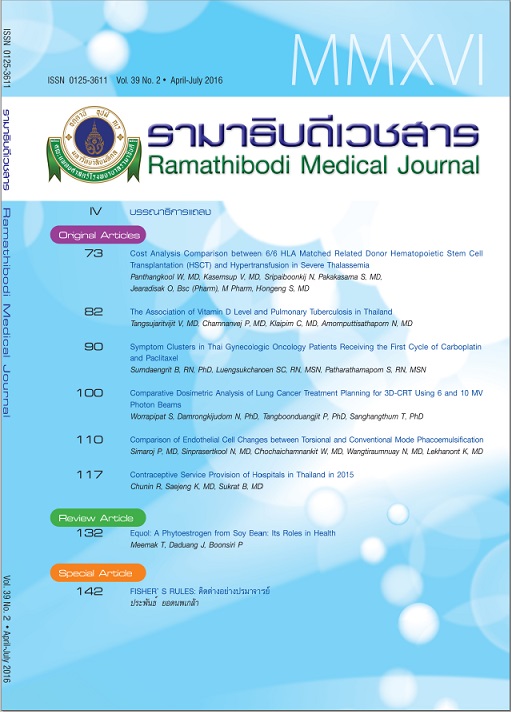Contraceptive Service Provision of Hospitals in Thailand in 2015
Main Article Content
Abstract
Objective: To exploring contraceptive services offered at both governmental and private hospitals for all types of health insurance coverage; and examining the results of contraceptive services provided by the hospitals before and after participating in the Prevention of Repeat Teenage Pregnancy Programme.
Meterials and Methods: A survey research was conducted and questionnaires were distributed to 627 hospitals countrywide. Moreover, executives and practitioners of 60 hospitals from 12 provinces and Bangkok Metropolitan selected with stratified random sampling method through STATA software were interviewed.
Rusults: The study findings revealed the followings: 1) for policy perspective, it was found that the provision of contraceptive services to all clients both under the Universal Health Coverage and the Prevention of Repeat Teen Pregnancy Programme were good policies that could help reduce problems of unplanned teen pregnancy and ensure equitable access among clients to the service. 2) Regarding contraceptive service provision, the study showed that there were such services available for all clients but not all types of contraception. This varied depending upon the contraceptive procurement of each hospital and clients’ needs. Services of public hospitals were offered to all age groups of population. It was also found the increasing of semi-permanent birth control services under the Prevention of Repeat Teenage Pregnancy Programme, with 16.3 percent and 21.4 percent increasing of intrauterine devices (IUD) and implants respectively. 3) For contraception supplies, most hospitals self-procured supplies by directly purchase from pharmaceutical companies based on the hospital committee’s decision. The disbursement of semi-permanent contraceptive supplies under the Prevention of Repeat Teenage Pregnancy Programme was well operated. Seventy-five point four percent of hospitals had not encountered any problems using e-claim system. 4) A number of challenges and gaps were indentified which included unawareness of some clients concerning their rights to health care services; lack of contraceptive information among teenagers; and not giving priority to contraceptive procurement of some hospitals’ administrators.
Based on the above results, some recommendations have been outlined; 1) National Health Security Office and Ministry of Public Health should prepare a clear and up-to-date manual for management and provision of family planning services for all hospitals in order to serve clients in accordance with their rights and needs under health insurance policy; 2) there should be an satisfaction evaluation of teenagers regarding service provision in order to improve services according to client needs and programme implementation in the next period; 3) educational materials should be also developed in various formats, multilanguage, and with up-to-date information and should be transmitted on easy access and popular channels for target groups especially teenagers; and 4) there should be capacity building of service providers both new and trained personnel for better quality and effective services.
Article Details
References
Mungkarndee T. Introduction of the National Family Planning Programme. The National Conference: Revolution of Thai Population, 14-17 March 1990. Chulalongkorn University Auditorium. Bangkok; 1990:6-8.
Chunil R, Panyadilok S. Satisfaction of family planning service. Bureau of Reproductive Health, Ministry of Public Health, Thailand. 2005:80.
Panyadilok S, Chunil R. Management of Family Planning System in Thailand. 2011:19.
National Health Security Office. National Health Security System in Thailand: User Manual. Thailand. 2005:80.
Saejeng K. Technology of Pregnancy Termination: Abortion Surveillance in Thailand, 30 November 2015. Narai Hotel. Bangkok; 2015:2-10.
Contraceptive service provision management. Bureau of Reproductive Health, Ministry of Public Health, Thailand. Bangkok; 2013:6-8.
Contraception for Adolescent. The Royal Thai College of Obstetricians and Gynaecologists. 2013;7(22):12-14.
Prevention of repeated pregnancy among postpartum teenage women. Bureau of Reproductive Health, Ministry of Public Health, Thailand. 2013:1-3.
https://www.klb.dmh.go.th/download_file.php?str_folder_name=ResearchFolderPath&str_file_name=RF-t1286251305.doc&field_id=230. Published 22 December 2012.
Pinyaphong J. Sexuality, risk perception, sexual risk behavior related to sexually transmitted disease (STDs) and AIDS of male adolescents : A case study of some Northern province. Uttaradit hospital medicalbulletin. 2009;24:1-11.
Panyadilok S, Chunil R. Management of Family Planning System in Thailand. 2011:43.
Taneepanichskul S, Yamarat K, Saejeng K, Chunil R. Analysis of family planning service. Bureau of Reproductive Health, Ministry of Public Health, Thailand. 2013:18.
Taneepanichskul S, Yamarat K, Saejeng K, Chunil R. Analysis of family planning service. Bureau of Reproductive Health, Ministry of Public Health, Thailand. 2013:18-19.
Panyaprutpong S, Nasoongnern B. The strategic approach and network of reproductive health program for the youth in Nakhon Ratchasima province. Journal of Public Health. 2012;42:55-67.
